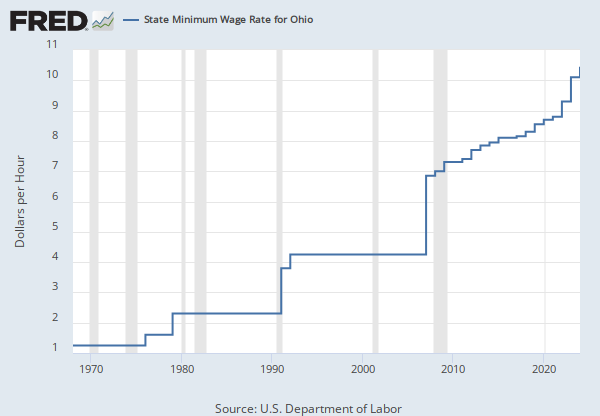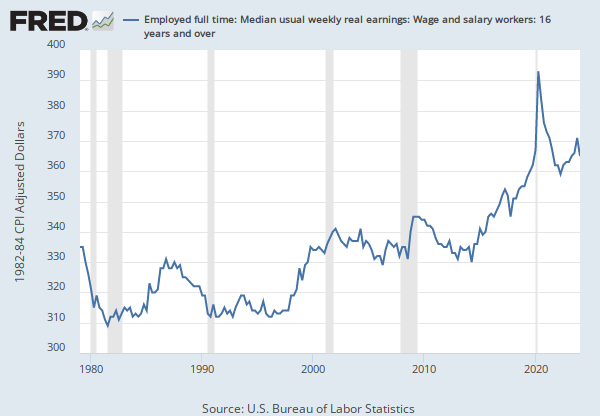Federal Reserve Economic Data
Data in this graph are copyrighted. Please review the copyright information in the series notes before sharing.
Notes
Source: U.S. Department of Labor
Release: Minimum Wage Rates
Units: Dollars per Hour, Not Seasonally Adjusted
Frequency: Monthly
Notes:
The federal minimum wage is the minimum hourly wage employers are required to pay employees who are eligible under the Fair Labor Standards Act (FLSA) of 1938. The FLSA was generally only applicable to employees involved in interstate commerce, either directly or through the creation of goods. Many amendments have since been added to the FLSA, expanding its coverage and raising the minimum wage. Significant amendments occurred in 1961 and in 1966, when a separate minimum wage for farm workers was established. Starting in January of 1978 the minimum wages of all eligible workers, including farm workers, were made uniform. The values in the series for non-farm workers are those for the groups initially covered under the 1938 FLSA. Many states also have minimum wage laws. Some state laws provide greater employee protections; employers must comply with both.
For additional information go to: http://www.dol.gov/whd/minwage/coverage.htm or http://www.dol.gov/whd/minwage/chart.htm#fn3
Suggested Citation:
U.S. Department of Labor, Federal Minimum Hourly Wage for Nonfarm Workers for the United States [FEDMINNFRWG], retrieved from FRED, Federal Reserve Bank of St. Louis; https://fred.stlouisfed.org/series/FEDMINNFRWG, .
Source: U.S. Bureau of Labor Statistics
Release: Employment Situation
Units: Dollars per Hour, Seasonally Adjusted
Frequency: Monthly
Notes:
Production and related employees include working supervisors and all nonsupervisory employees (including group leaders and trainees) engaged in fabricating, processing, assembling, inspecting, receiving, storing, handling, packing, warehousing, shipping, trucking, hauling, maintenance, repair, janitorial, guard services, product development, auxiliary production for plant's own use (for example, power plant), recordkeeping, and other services closely associated with the above production operations.
#Nonsupervisory employees include those individuals in private, service-providing industries who are not above the working-supervisor level. This group includes individuals such as office and clerical workers, repairers, salespersons, operators, drivers, physicians, lawyers, accountants, nurses, social workers, research aides, teachers, drafters, photographers, beauticians, musicians, restaurant workers, custodial workers, attendants, line installers and repairers, laborers, janitors, guards, and other employees at similar occupational levels whose services are closely associated with those of the employees listed.
The series comes from the 'Current Employment Statistics (Establishment Survey).'
The source code is: CES3000000008
Suggested Citation:
U.S. Bureau of Labor Statistics, Average Hourly Earnings of Production and Nonsupervisory Employees, Manufacturing [CES3000000008], retrieved from FRED, Federal Reserve Bank of St. Louis; https://fred.stlouisfed.org/series/CES3000000008, .
Related Data and Content
Data Suggestions Based On Your Search
Content Suggestions
Other Formats
Related Categories
Releases
Tags
Permalink/Embed
modal open, choose link customization options
Select automatic updates to the data or a static time frame. All data are subject to revision.
























